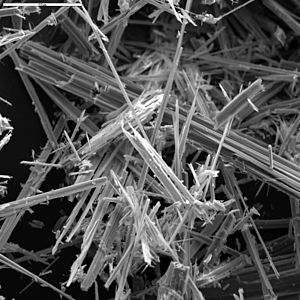IARC Classification
IARC Classification and Examples[edit | edit source]
This is a list of substances classified according to their dangerousness, based on the Ames Test (IARC) follows. IARC stands for International Agency for Research on Cancer.
Group 1 Carcinogens[edit | edit source]
[107 agents]: The agent (mixture) is definitely carcinogenic to humans. The exposure circumstance entails exposures that are carcinogenic to humans. There is enough evidence of the agents in this group to support carcinogenicity in humans. In some cases an agent (mixture) may be in this class when evidence of carcinogenicity in humans is less than enough, however there is enough evidence in experimental animals and more than enough evidence in exposed humans.
| Aflatoxin | Benzidine | HIV |
| Arsenic | Ethanol | 2-Naphthylamine |
| Asbestos | Vinyl Chloride | Helicobacter pylori |
| Benzene | Benz[a]pyrene | HPV |
Group 2A Carcinogens[edit | edit source]
[58]: The agent (mixture) is probably carcinogenic to humans. The exposure circumstance entails exposures that are probably carcinogenic to humans. This IARC class is used when there is little evidence of carcinogenicity in humans but enough evidence of carcinogenicity in experimental animals. Occasionally an agent may be classified in this category when there is less than enough evidence of carcinogenicity in humans and sufficient evidence of carcinogenicity in experimental animals and strong evidence that the carcinogenesis is mediated by a mechanism that also operates in humans.
| Inorganic lead | Acrylamide | Dibenz[a,h]anthracene |
| UV | Benz[a]anthracene | Chloramphenicol |
Group 2B Carcinogens[edit | edit source]
[249]: The agent (mixture) is possibly carcinogenic to humans. The exposure circumstance entails exposures that are possibly carcinogenic to humans. This class is used for agents, That show little evidence of carcinogenicity in humans and less than adequate evidence of carcinogenicity in experimental animals. It can also be used when there is inadequate evidence of carcinogenicity in humans but there is enough evidence of carcinogenicity in experimental animals.
| Lead | Caffeine | Acetaldehyde |
Group 3 Carcinogens[edit | edit source]
[512]: The agent (mixture or exposure circumstance) is not classifiable as to its carcinogenicity to humans. This class is used mostly for agents, for which the evidence of carcinogenicity is less than enough in humans and less than enough or little in experimental animals. Exceptions include when agents for which the evidence is less than enough in humans but enough in experimental animals can be situated in this category when there is strong evidence that the mechanism of carcinogenicity in experimental animals is not the same in humans.
| Acrylic fibers |
Group 4 Carcinogens[edit | edit source]
[1]: The agent (mixture) is probably not carcinogenic to humans. Caprolactam
| Caprolactam |
Links[edit | edit source]
Related articles[edit | edit source]
Bibliography[edit | edit source]
- BENCKO CHARLES UNIVERSITY, PRAGUE 2004, 270 P, V, et al. Hygiene and epidemiology. Selected Chapters. 2nd edition. Prague. 2008. ISBN 9788024607931.


